Back in July, we reported on the release of two new Godox flashes with a distinctive, retro look: the Godox Lux Senior and Lux Junior. Godox kindly sent us one of each to try out, and this article – based on a couple of months of extensive testing – is an in-depth review and comparison of the two flashes. (For a less detailed but possibly more fun take, check out my earlier article: first impressions of the Lux Senior.)
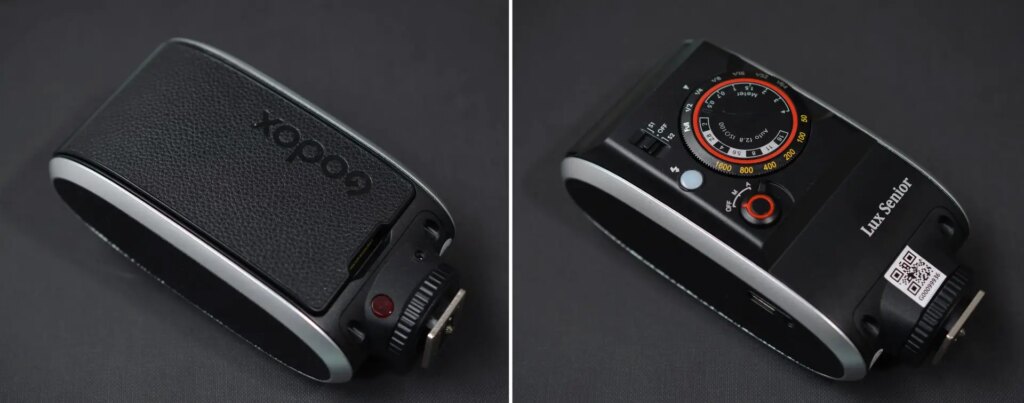
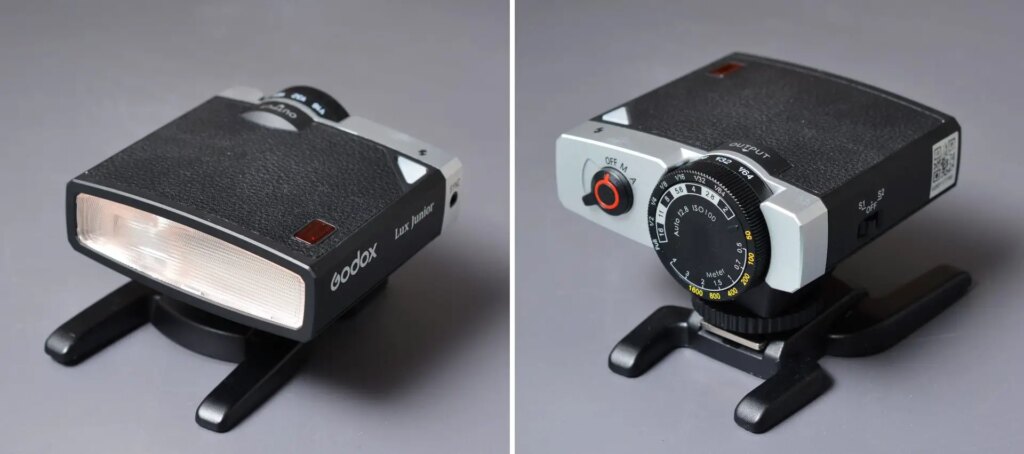
Specs and features
The Godox Lux flashes are defined by their retro design, and are possibly the coolest-looking flashes currently on the market. They are compatible with pretty much any camera – film or digital – which has a hotshoe or PC sync port.
The Lux flashes are admittedly not as feature-packed as some of Godox’s other offerings – the TT685 and TT350, for example, which are in the same price bracket as the Senior and Junior respectively. However, they are more advanced than many film-era flashes. For instance, the flash power can be controlled both automatically and manually, from Full power down to 1/64. They also have optical control, which means they can be used off-camera, firing synchronously when they “see” another flash (I used this feature for my header image, among others).
Spec sheet
The following specs are taken from the Godox website, except the ones in blue.
| Godox Lux Senior | Godox Lux Junior | |
| Guide number (Full power) | 14 (ISO 100, metres) | 12 (ISO 100, metres) |
| Flash power | 7 levels (1/1 – 1/64) | 7 levels (1/1 – 1/64) |
| Colour temperature | 6000K ± 200K | 6000K ± 200K |
| Focal length | 28mm (fixed) | 28mm (fixed) |
| Battery | Lithium, 3.7V 1700mAh | Two AAA batteries |
| Recycle time (Full power) | <3 sec | 5 sec* |
| Sync | Hotshoe, sync cable | Hotshoe, sync cable |
| Optical control | S1/S2 | S1/S2 |
| Dimensions | 84mm×114mm×176mm | 74×50×72mm |
| Weight | 227g | 130g |
| Price | £115** | £65** |
* Based on my personal tests with new Energizer AAA batteries. (The numbers, for both flashes, are at Full power. At 1/64 power, recycle time is almost instantaneous.)
** Price on Amazon UK at the time of writing.
Your eyes probably glazed over all that info. That’s okay. In the next few sections I’ll take you through what these specs mean in practice.
Similarities
Aesthetics: Both flashes sport a retro look. Compared to conventional speedlights (I use the terms “speedlight” and “flash” interchangeably), I think the Godox Lux series is aesthetically a better fit with film cameras, or retro-styled digital cameras like the Fuji X-series. (For more on aesthetics, see below.)
Power: They both have Auto and Manual modes to adjust the flash power, which ranges from Full power to a minimum of 1/64 in one-stop intervals. In subsequent sections of this review, I go into more detail on these modes.
Sync: Both flashes can be fired:
- on-camera (hotshoe),
- off-camera with a sync cord (supplied), or
- off-camera with optical control (see below).
Differences
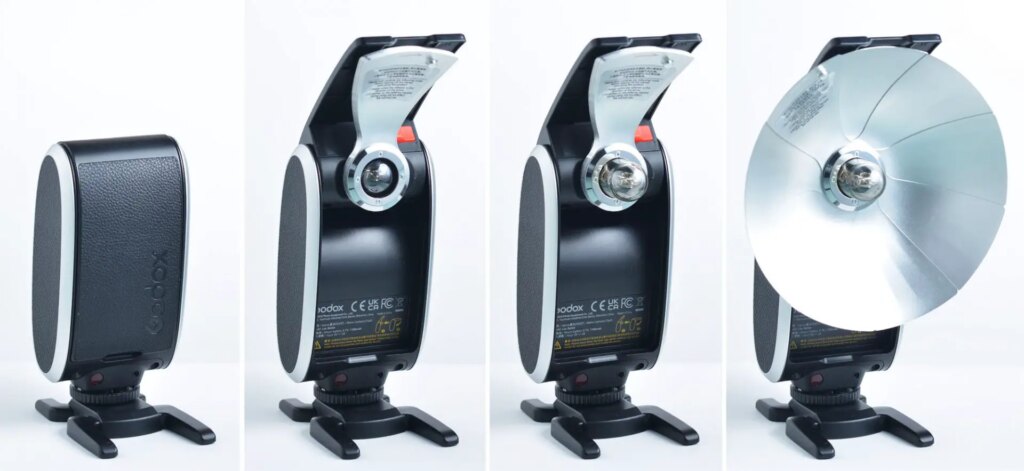
Construction: The Godox Lux Senior folds out in three stages: open the main cover, pop out the flashbulb, unfurl the fan-like silver reflector (you can also see the process in this Instagram reel I made). The Lux Junior has a simpler construction; what you see is what you get.
Light source: The Godox Lux Senior has a bare bulb – a curved flash tube (below left). In use, the bulb is surrounded by a reflector dish which effectively creates a bigger, softer light source. The Lux Junior, on the other hand, has a more typical discharge tube fronted by a Fresnel panel. The Fresnel – as explained in this article – is like a lens. Without it, light rays from the discharge tube would fan out in all directions. The Fresnel concentrates them into a front-facing beam of a higher intensity. The Lux Junior thus produces a harder light, similar to a conventional speedlight (I’ve compared the light quality in a later section).
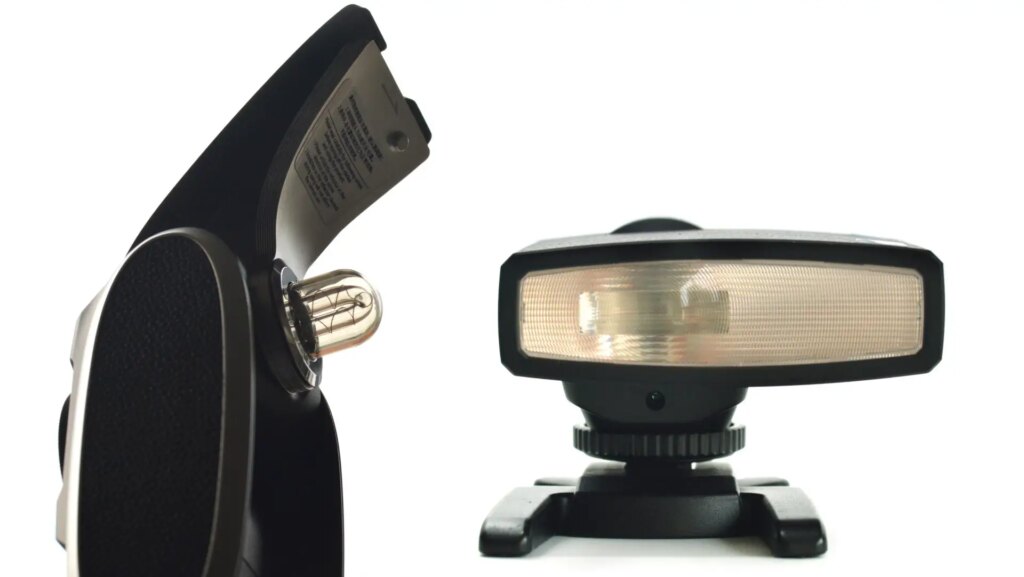
Size and weight: The Godox Lux Senior is bigger (though it folds up quite small) and about 75% heavier than the Lux Junior. But even the Senior is smaller and lighter than a conventional speedlight like the Godox TT685 (410g without batteries).
Power: According to Godox spec sheets, the Lux Senior (GN 14) is slightly more powerful than the Lux Junior (GN 12). However, my tests (see below) suggest the opposite.
Battery and recycle time: The Godox Lux Senior runs on a Lithium battery, which also contributes to its faster recycle time. The battery is charged by plugging a USB-C cable (supplied) into the flash unit. This is super convenient. My only gripe is that, since lithium batteries tend to lose their charge-holding capacity over time, I would have preferred the battery to be replaceable (not integrated, as in the Lux Senior).
The Lux Junior runs on two AAA batteries. The recycle time is slightly slower, but if you run out of juice, it’s easy to carry (or buy) spare AAA batteries, whereas the Lux Senior has to be plugged in for recharging. For the Lux Junior, I recommend using rechargeable batteries to reduce e-waste and save money in the long term (I use Ikea Ladda batteries and the Stenkol charger).
Colour gels: Because of its shape, it’s easy to use colour gels on the Godox Lux Junior. On the Lux Senior, gelling would be trickier, probably requiring a hack of some sort. For the image below, I simply attached a red gel to the Lux Junior with a rubber band, as shown at top right. Bottom right shows the setup (but without my hand).
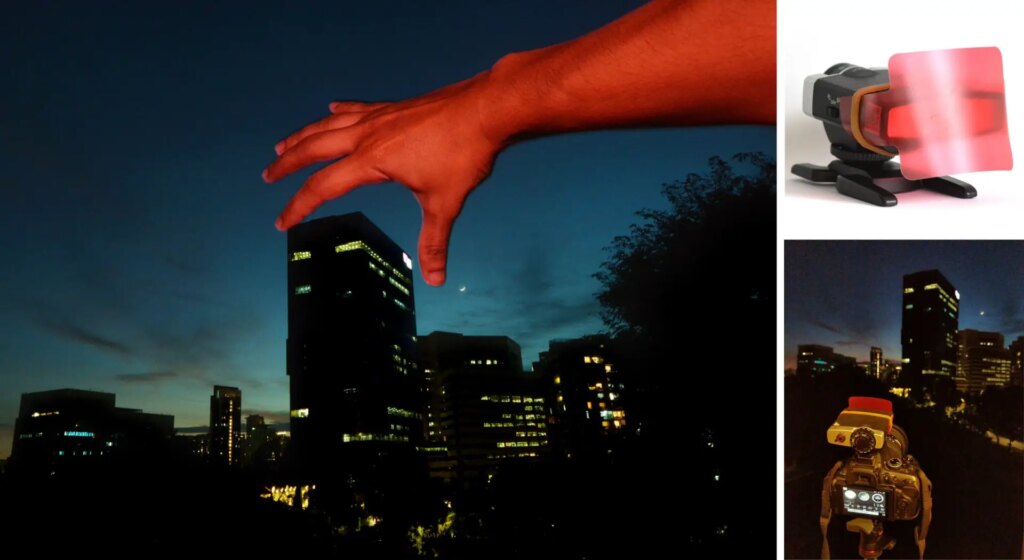
Compatibility
The Lux Junior product page lists the “compatible cameras” as Fujifilm, Canon, Nikon, Olympus and Sony. But both flashes also worked with my Minolta SLR (hotshoe), and my Minolta Autocord TLR (PC sync port, since it only has a “coldshoe”). In fact I see no reason why they wouldn’t work with any other film or digital camera, as long as it has a hotshoe or sync port.
Packaging
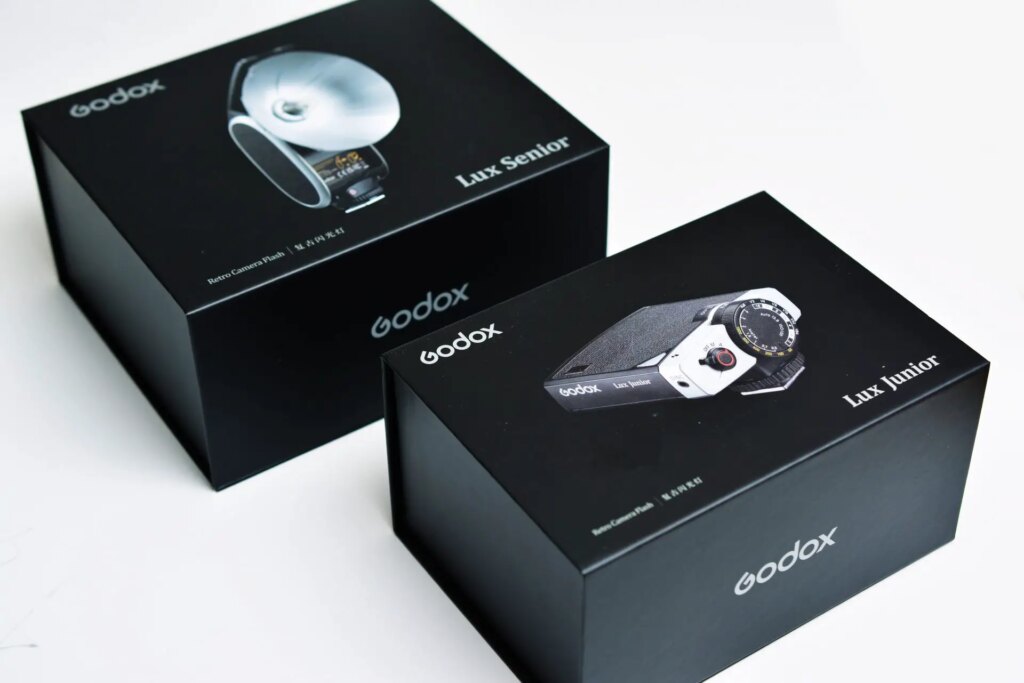
Like the flashes themselves, the packaging looks and feels good – honestly a cut above what I would expect for accessories at this price point. The boxes have a matte black finish and a magnetic lid. They also include a cloth bag, manual, PC sync cord and, in case of the Godox Lux Senior, a USB-C charging cord.
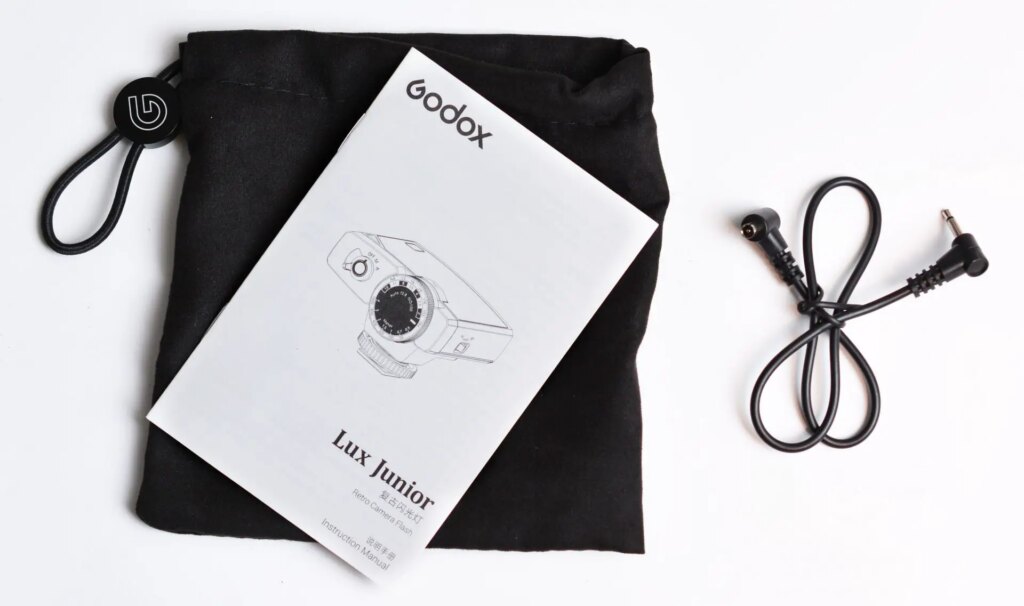
Missing features
There are some features which are available on many conventional speedlights (e.g. the Godox TT685), but not on the retro-styled Lux series: tilt, swivel, zoom, TTL, radio receiver and high-speed sync. If these features are important for you, the Lux series may not be a good fit. But they do have other advantages – they look cool, are relatively cheap and compact, and as my sample photos will hopefully show, there’s still a lot you can still do with these flashes.
Look and feel
Conventional speedlights are versatile marvels of technology – I like my Godox TT350 and TT600 and use them often – but let’s face it, they are not particularly pretty. With the Lux series, Godox clearly wanted to make the aesthetics a selling point, and in my view, it’s a real success.
The Lux Junior, to my eyes, has more of a 1970s/80s aesthetic, perhaps best suited to smaller cameras such as fixed-lens rangefinders and manual-focus SLRs. The Lux Senior harks back to an older design, the kind of flashes often seen with TLRs and Speed Graphic cameras. Despite the outward differences, both Lux flashes share some design features that identify them as belonging to the same series – faux-leather trim, chrome accents and physical dials. The review copies which I tested were black, but Godox have also released multi-coloured versions.

Now you might say: instead of vintage-looking modern flashes, why can’t we buy actual vintage flashes? You can, but there are some downsides. Many film-era flashes have discharge voltages which will fry modern cameras (this excellent article by Matt Wright on Emulsive goes into more detail). Older flashbulbs, like those from which the Godox Lux Senior draws design inspiration, were single-use; you had to replace the bulb each time it fired. (They had other disadvantages too – took a while to reach full power, were too hot to handle for a while after going off, and so on – but the single-use limitation alone makes them too impractical for most of us.)
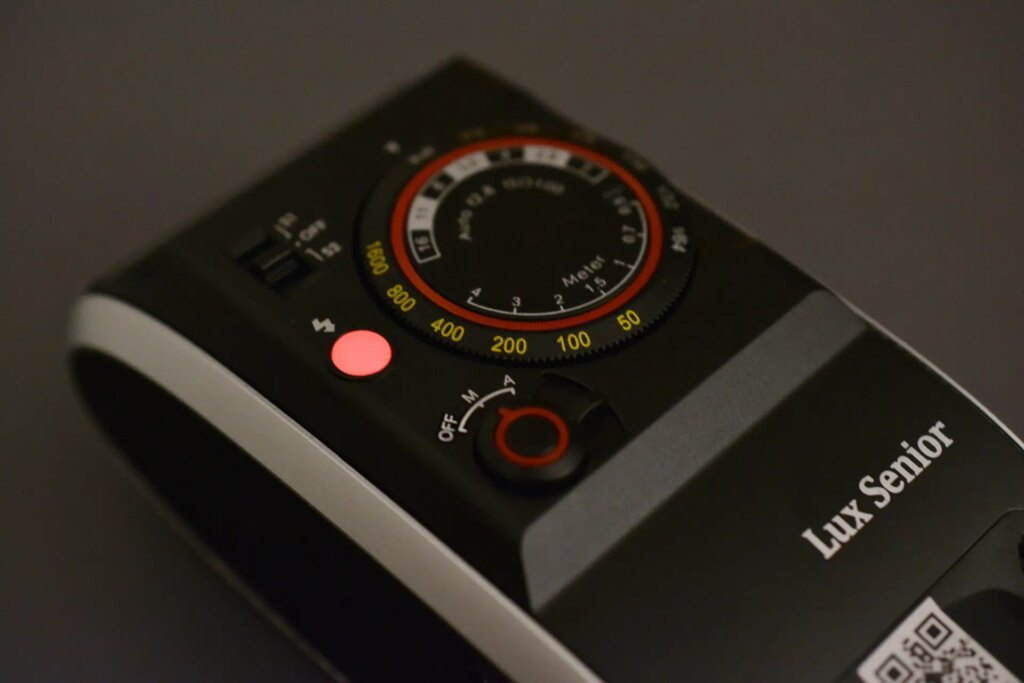
The haptics and finish of the Lux flashes are excellent, with switches and dials that click satisfyingly into place. For me, the analogue-style dials are a lot nicer to use than the buttons and LCDs on modern speedlights. An added benefit is that even before you switch it on, you can see (and change) the flash power.
Equipment used
The digital photos in this article were shot with my trusty old Nikon D5200, with an AF-S Nikkor 50mm f/1.8 and Sigma 10-20mm f/3.5. The film photos were shot with a Minolta Autocord TLR and a Minolta X-370s SLR.
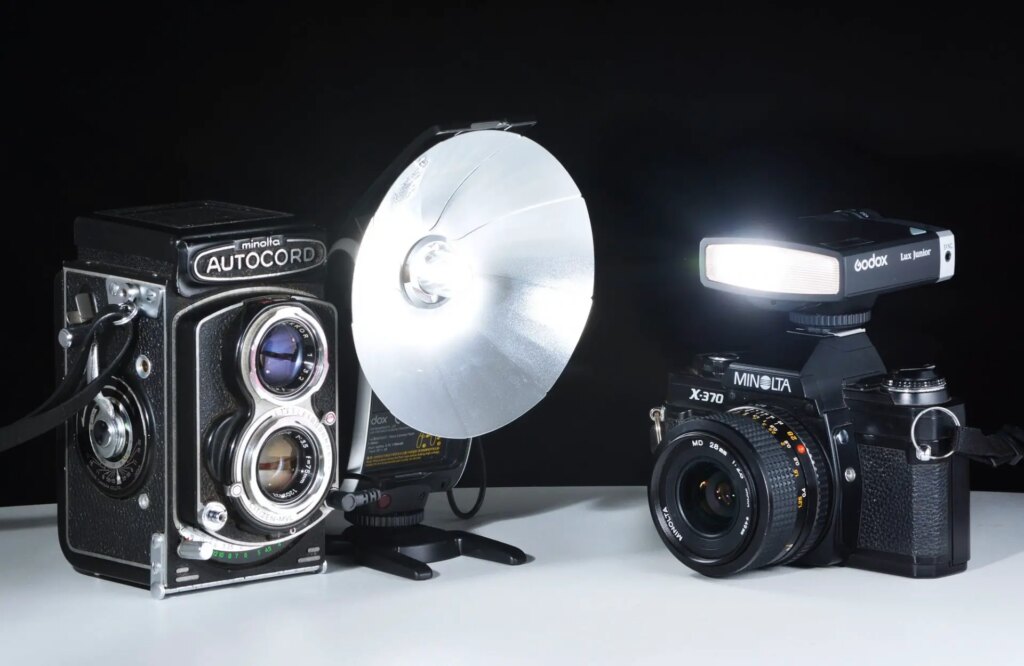
Camera settings for the digital photos, obtained from the metadata, are noted in captions. For the film photos, I didn’t take exposure notes. Life is too short…
Flash used was either the Godox Lux Senior or Lux Junior, also noted in captions. Both flashes can be used in either Manual or Auto mode. I used Manual mode for all photos except the ones in the Auto section. I didn’t always note the flash power, but that’s not so critical. What is important is that all these photos were achievable at somewhere between minimum (1/64) and full power.
Some terminology
There are a couple of terms I’ll use throughout this article. If you’re familiar with flash, and especially if you learned at the school of David Hobby, you probably know these terms already, so feel free to skip ahead. But if you’re a beginner (or simply rusty), it’s worth defining some basic terminology:
- Flash exposure
- Ambient exposure
- Dropping the ambient
- Killing the ambient
Flash exposure is the light from the flash itself, as recorded by the film or digital sensor. All other light is ambient exposure. Note that “ambient” doesn’t necessarily mean “natural light”. The light from a table-lamp or neon sign also counts as ambient light.
Dropping the ambient is to make the ambient exposure darker by underexposing. The three photos below illustrate what I mean. In the first one, the exposure is “correct” for the foreground subject (my friend, Mayank). But the light is flat, and the background is blown out.

In the next photo, I “dropped the ambient”. By using a faster shutter speed, we get nice saturation in the background. But now Mayank himself is practically a silhoutte.

The next photo has the same exposure settings as the previous one, but I used flash to light Mayank.

Now I realise this is not the most “natural” image, but at least there’s good detail in both foreground and background. By placing the flash off-camera, and by using a softbox or other modifiers, I could have obtained a more natural-looking result. But at this stage, I want to keep things relatively simple – it’s just a demo, nothing more.
If you drop the ambient even further so that there’s effectively no ambient exposure at all, that’s known as killing the ambient. At this point, all the light comes from the flash exposure.
The photo below was shot without flash, lit entirely by ambient light.

For the next photo, taken right after, I underexposed by 7 stops, effectively “killing the ambient”.

Now add flash, and you get a very different and dramatic picture. The flash lights up the subject, but the underexposed background is still completely dark.
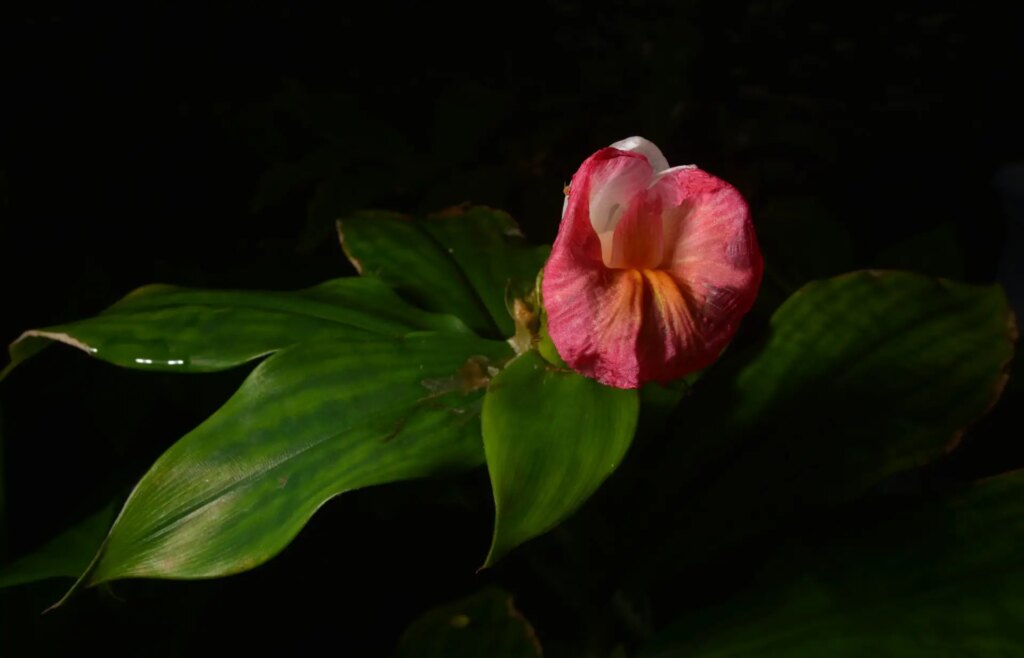
Manual and auto modes
On the Godox Lux flashes, the On/Off switch also doubles as the Manual/Auto switch. When you turn the flash on, you automatically choose one of these two modes.
Manual
The Godox Lux Senior and Lux Junior flashes both have adjustable power (technically, it’s the flash duration which changes, not the power) ranging from Full power to a minimum of 1/64, at one-stop intervals (Full, 1/2, 1/4, 1/8 … 1/64). This is a vital feature – another degree of freedom, one more variable we can tweak to obtain the desired blend of ambient and flash exposure.
The rear dial has an outer ring which controls the flash power, and an inner ring which is basically an exposure calculator (with no effect on flash output). The calculator is straightforward. If you understand the relationship between ISO, aperture and shutter speed, you can master the dial in a matter of minutes.
Let’s say you’re using ISO 100, and your subject is at a distance of 3 metres. You simply turn the inner dial to line up the ISO and distance, as shown below left. The top half of the dial then shows you a few combinations you can use: Full power and f/4, 1/2 power and f/2.8, 1/4 power and f/2. (The shutter speed doesn’t affect the flash exposure; as long as you’re at or below the sync speed, it only affects the ambient.)
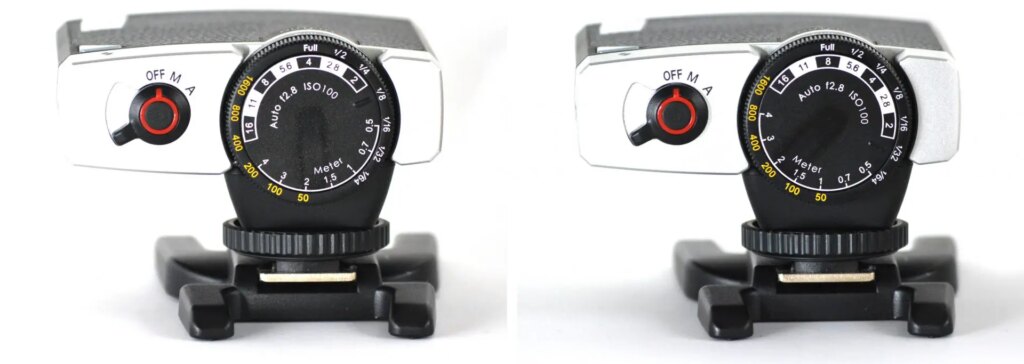
What if you wanted to use a smaller aperture, say f/8? With film, you’d probably need to move closer to the subject. On digital, you can simply increase the ISO. In the image at above right, I’ve turned the inner dial clockwise to line up ISO 400 and 3 metres. Now the dial tells you that you can use Full power and f/8. Like I said, simple.
Of course, the dial is an approximation. In certain situations – say if you’re mixing ambient light and flash, or using colour gels – the dial values may not give you the result you’re looking for. I feel it is most useful with film cameras, because most modern flashes have no such guide at all. When shooting digital, I rarely refer to the dial. I have a rough idea based on prior experience, and then I fine-tune it by chimping (take a photo, look at the LCD, adjust as necessary, take another).
Auto
On the Godox Lux flashes, Auto mode assumes you’re using ISO 100 and f/2.8. Equivalent settings would also work, such as ISO 50 and f/2, or ISO 200 and f/4. (The shutter speed, as noted earlier, does not affect the flash exposure, as long as you stay within the sync speed.) The manual warns that Auto mode may not work as intended if the subject is more than 4 metres away, or if you use an “extra long lens”.
Like any other automated feature on a camera, Auto mode may not give you optimal results in all situations, but it mostly does the job.


The next photo was with the same settings as the one above, but without flash:
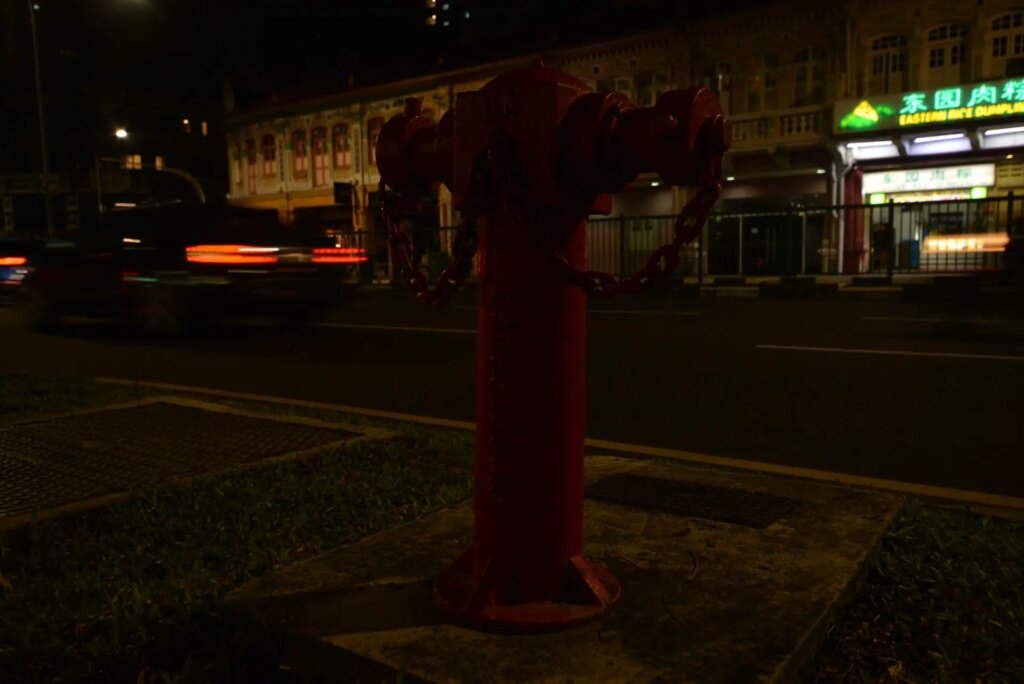
So how does Auto mode work? Now we’re wading into nerd territory, and you don’t really need to know this, so feel free to skip to the next section. But here’s my theory.
Both Lux flashes have a tiny sensor on the front, which the manual describes as an “auto light receptor”. I think what it really does is to estimate the distance between the flash and the subject (with infrared, perhaps?) and adjust the flash power accordingly.
Here’s a test. For all six of the test shots below, I killed the ambient, so the only illumination comes from the flash (Godox Lux Senior).
A and C were both shot on Auto mode, but for C, I went closer, zooming out so that the subject looks similar in size. The exposure, as you can see, is similar (C is slightly brighter, but a little inconsistency is to be expected).
With B and D, I tried to manually match the respective Auto exposures. In case of B (3 metres), 1/16 power did the trick, but for D (1.2 metres), I had to go all the way down to 1/64.
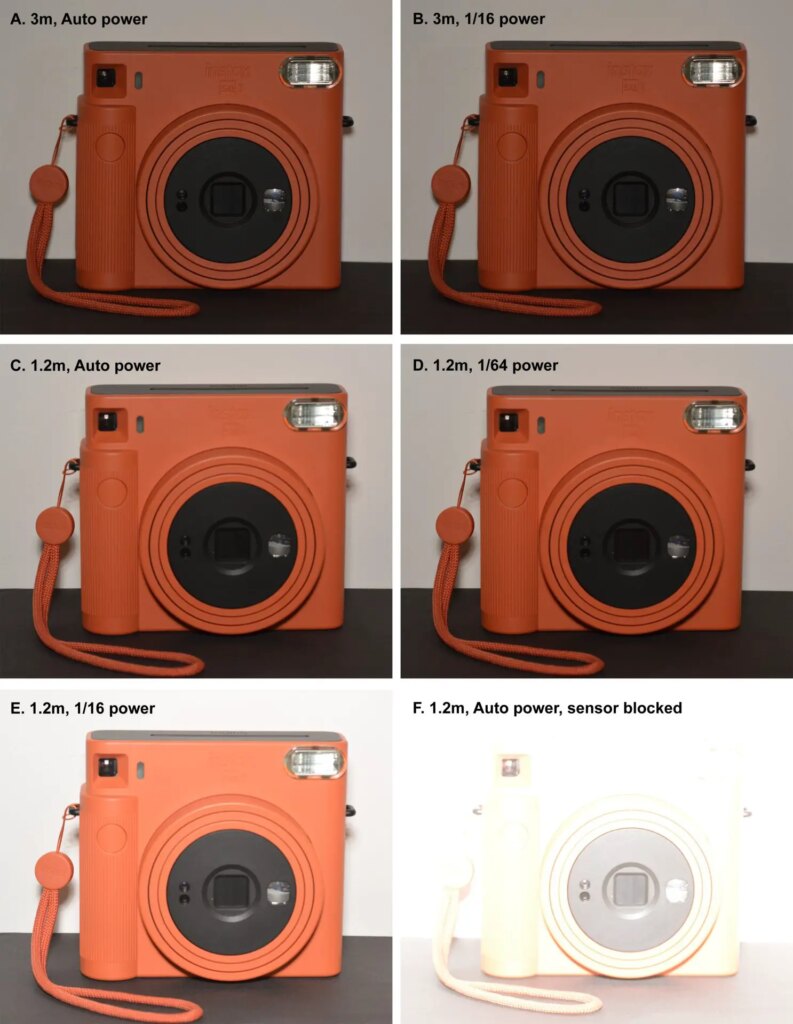
E shows that at 1/16 power (same as B), the image is over-exposed. That makes sense, because E is from a closer distance. Finally, F shows what happens in Auto mode if I cover the sensor with my finger. The flash fires at maximum power, which at this range means blowing out the subject.
As I said, I suspect that the sensor is measuring subject distance (as opposed to reflected light, as in thyristor or TTL systems). This has one advantage. Reflective meters are often fooled if the subject is dark or bright. In the two photos below, the Godox Lux Junior, in Auto mode, correctly exposed the Instax photo although it takes up only a small part of the frame. The backgrounds (black bedsheet and white wall) which dominate the respective frames didn’t fool the sensor into over- or under-exposing.
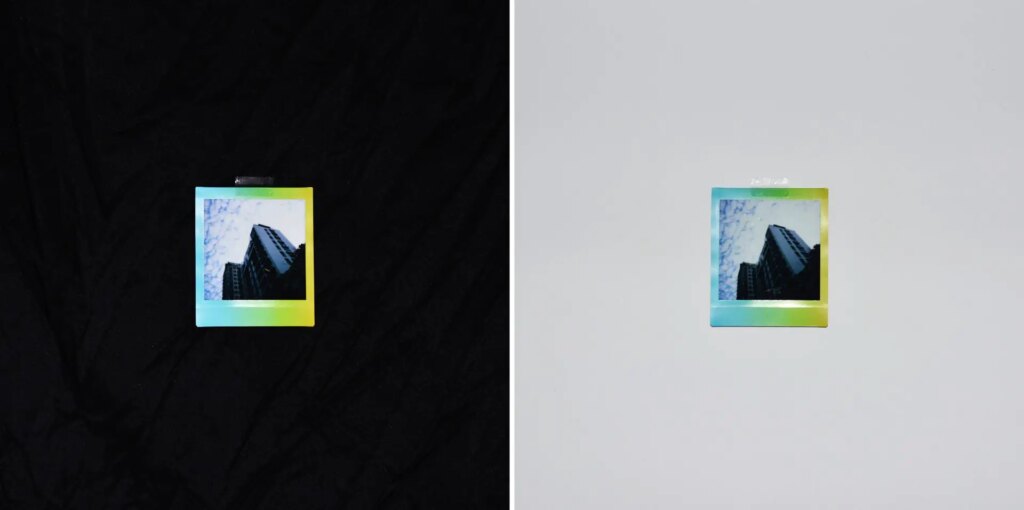
Light quality, power and colour
The photo below shows the light quality from three different flashes:
- Godox Lux Senior
- Godox Lux Junior
- Godox TT600 – a conventional speedlight.
All three flashes were set to 1/64 power. The TT600 was set to 28mm zoom. The Lux flashes are not zoomable, but according to the spec sheet, they have 28mm coverage.
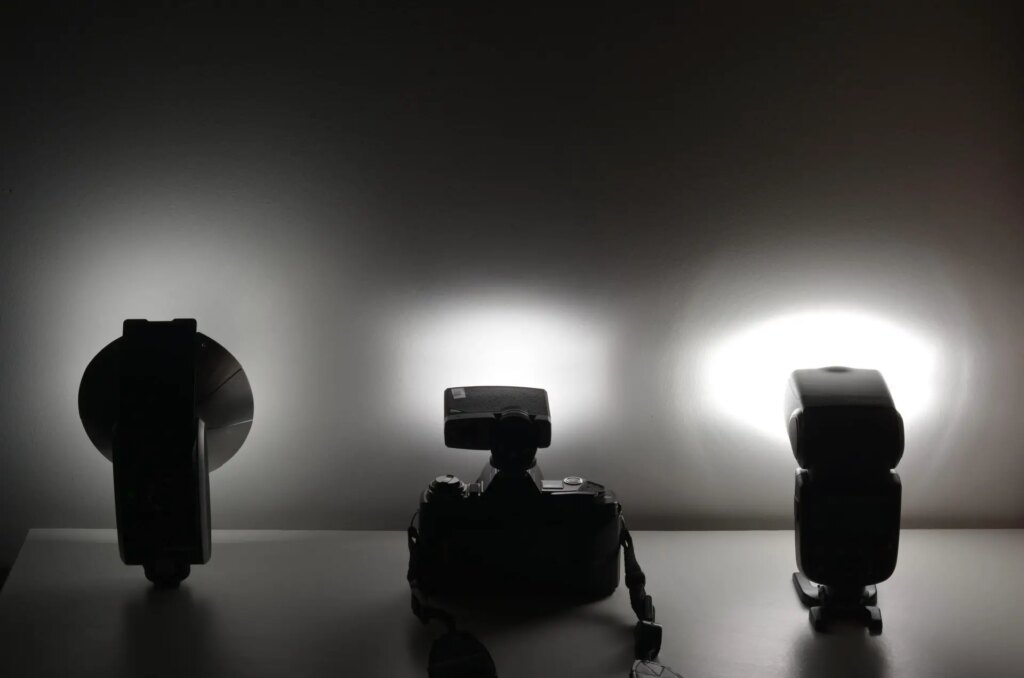
First, light shape. As you can see, the Lux Senior’s reflector functions like a small beauty dish, creating a soft, fuzzy circle of light. The Lux Junior and the TT600 (conventional speedlight) are fronted by Fresnel panels and have a similar shape – a hard, rugby-ball shaped beam. The beam has a fairly even intensity within the confines of that shape, and rapid fall-off beyond.
Now let’s talk about light power. The next section has a more in-depth discussion including Guide Numbers, but all technicalities aside, you can already see from the photo above that when set to the same power level – 1/64 for all three flashes – the Godox Lux Senior is weaker than the Lux Junior, which in turn is weaker than the TT600.
What does this mean for real-world photos?
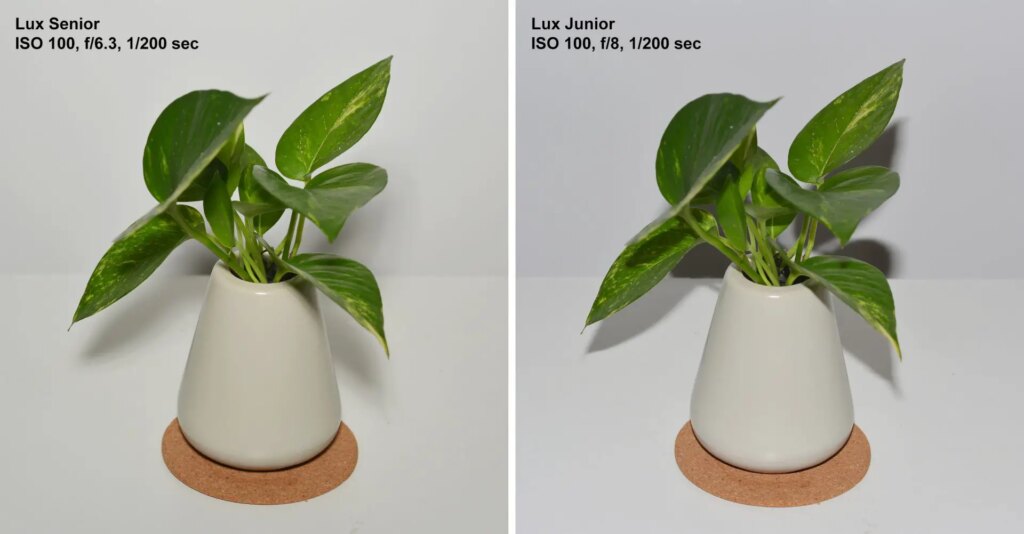
In terms of light quality, the leaf shadows are evidently softer with the Lux Senior, and harder with the Lux Junior. This is because the Lux Senior’s reflective dish creates an effectively larger (and therefore softer) light source.
Both flashes were set to the same level (1/64), but with the Lux Junior, I had to stop down slightly (from f/6.3 to f/8, i.e. 1/3rd stop) to get the same exposure. This supports the evidence from the previous photo that the Lux Junior is slightly more powerful.
Finally, the Lux Junior seems to have a slightly cooler (bluer) colour temperature. (For both photos, my camera white-balance was set to Cloudy.)
These conclusions – that the Godox Lux Senior is softer, slightly weaker, and warmer – are corroborated by all my tests so far. In the comparison below, the left (Lux Senior) and middle (Lux Junior) photos use the same exposure settings, but as you can see, the middle photo is slightly brighter. In the right photo (Lux Junior again), stopping down from f/5.6 to f/7.1 produces an exposure which is closer to the Lux Senior.
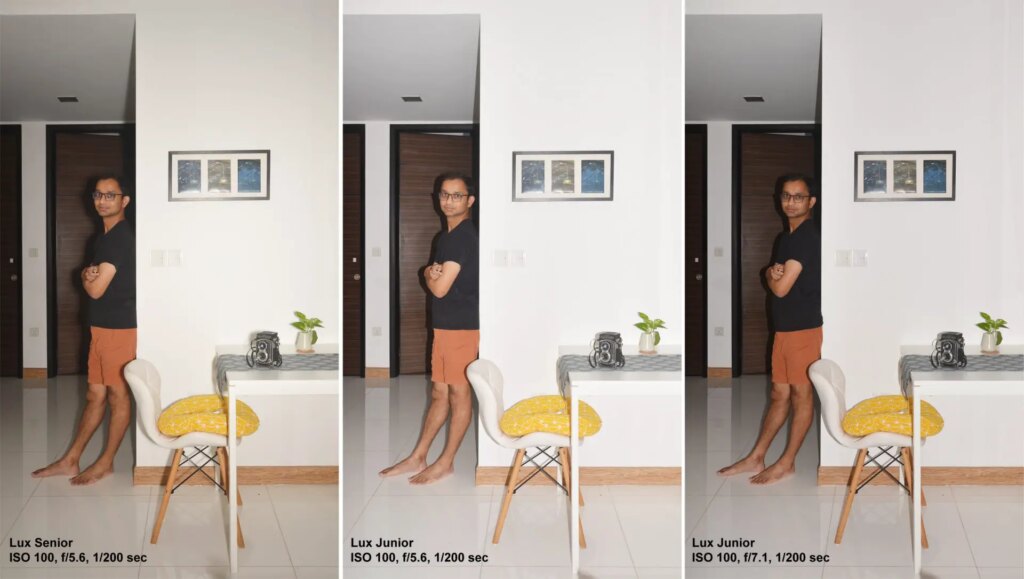
The close-ups below show, once again, that the Lux Senior produces softer shadows than the Lux Junior.
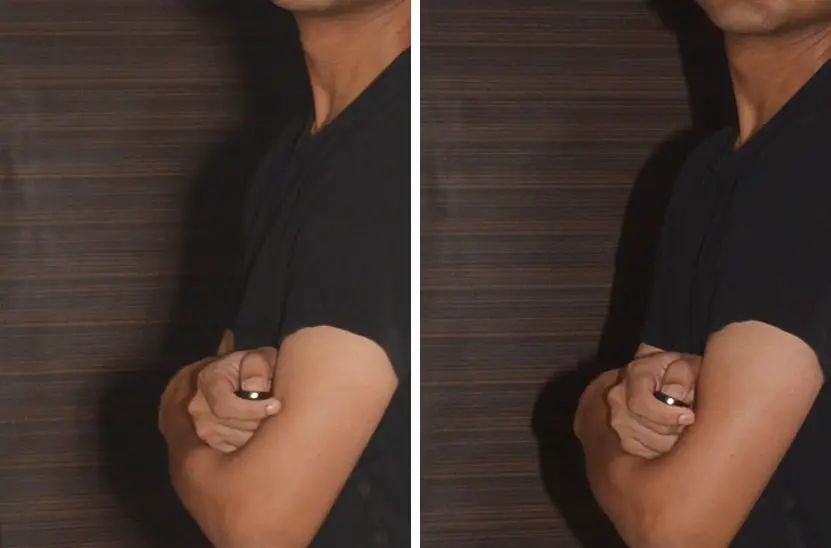
When it comes to light quality, the shadows are the most obvious difference, but the Lux Senior also has an overall softer and more rounded light. This is a more subtle effect, but it makes a difference, especially for portraits. In the photos below, the specular highlight on her brow is more smeared out in the second photo (Lux Senior) and harder in the third (Lux Junior).



In my earlier post about the Godox Lux Senior, I shared some street portraits (I’ve reproduced one of them below; for the rest, please see my original article).

In shots like these – I used a wide-angle lens at close quarters – the Lux Senior’s reflector creates an effectively larger light source, so the quality of light is softer and more rounded than what I have come to expect from on-camera flash. Of course, softer is not necessarily better. If you want a harder, more edgy aesthetic, the Lux Junior may be a better tool for you.
Guide number
The reported Guide Number (GN) for the Godox Lux Senior and Junior flashes are 14 and 12 respectively. For purposes of this review, you don’t need a technical understanding of GN (see this explanation, if you’re interested). All you need to know is that other things being equal, a higher GN indicates greater flash power.
The other things being equal is crucial. When the specs for the Lux Senior and Junior flashes were first announced, I saw a lot of online comments bemoaning their low GN. My take on this is that (a) these flashes are not as weak as the GN might suggest, and (b) to the extent that they are weaker than some other speedlights, it’s not a problem for the type of scenarios in which I foresee these flashes being used.
Let’s talk about GN first. Most modern flashes have zoom capability, that is, you can control the spread of light. Just like a hosepipe, a narrower beam means more power, which translates to a higher GN. On spec sheets, the GN for flashes with zoom capability is often reported at the longest focal length, so it sounds more impressive. For example, the GN for the Nikon SB800 – a classic speedlight – is 56. But that figure is for when the flash is zoomed to 105mm. At 28mm – as you can see from the manual (PDF) – the GN drops to 32.
When you consider that the Godox Lux Senior and Lux Junior are “fixed focal length” flashes with a relatively wide beam (28mm, according to the spec sheet), a GN of 14 or 12 is not bad.
Besides, specs are all very well, but at the end of the day, I trust real-world experience: how does it perform in the field? I’ve used these flashes extensively over the last couple of months, and my takeaway is that they are sufficiently powerful for most common scenarios. In fact, I was pleasantly surprised by how powerful they are.
Now if you want to light up a whole basketball court, or overpower the sun at high noon, these flashes evidently won’t do the job. For such scenarios, Godox and other manufacturers offer more powerful (but also bigger and more expensive) lighting solutions. But the Lux flashes are more than adequate for taking photos on a night-out with friends, or as fill flash in the daytime. They can even kill the ambient, if the ambient is not too strong.
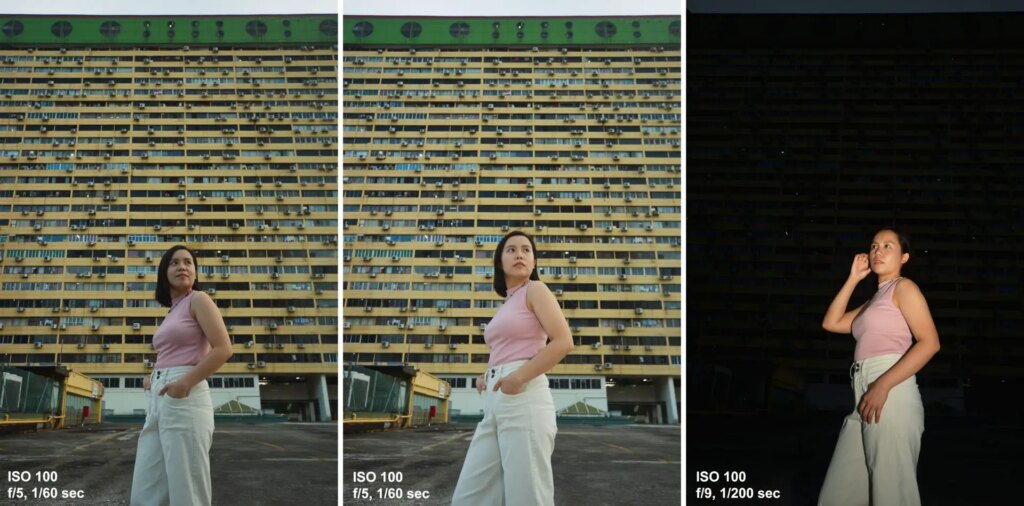
The photos above – with Pearl, an actor – were shot in a span of just four minutes, so there was little or no change in ambient light. The difference in illumination is entirely down to camera settings. The first photo is ambient light only. The second photo has the same settings, but I used fill flash, at low power, to make her pop.
In the third photo, I underexposed by 3⅓ stops, effectively almost killing the ambient (you can still see a hint of detail in the building, and a sliver of sky above it). But by ramping up the flash power, Pearl herself is still well-lit.
These three photos, I think, are a good demonstration of how versatile these flashes are. By changing only the camera settings and flash power, I could achieve vastly different effects – from just a soupçon of fill flash, to killing the ambient almost entirely in order to light the subject with flash alone.
Here’s another demonstration of flash power: the Lux flashes are strong enough to light a whole big tree! (I chose an exposure that looked “right” to my eyes, but with a higher ISO, I could have made the tree even brighter.)
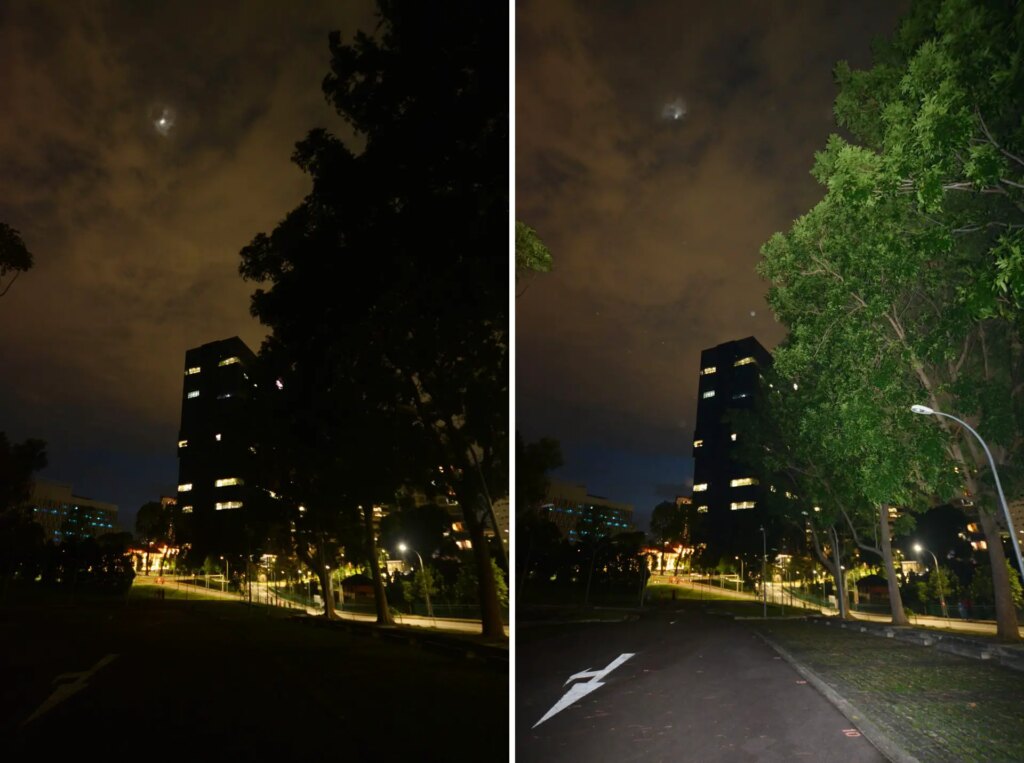
Flash sync
Off-camera flash
The photos in the Guide number section above, and most of the other photos in this article, were taken with on-camera flash, i.e. with the flash mounted on the camera’s hot-shoe.
But the Lux flashes can also be used off-camera. First, if your camera has a flash port, you can use a sync cable to connect the flash. Both Lux flashes come with a PC sync cable, which is what I used with my Minolta Autocord (see below). If your camera has a different type of port, or if you want a longer cable, you should be able to buy one online. Sync cables are typically inexpensive and widely available.
The second option is optical control. (It used to be called “optical slave”, but the term is now deprecated – for good reason! – and most companies including Godox have phased it out.) Essentially, this means that the flash will fire synchronously when it “sees” another flash. Both Lux flashes have two optical control modes: S1, where it fires instantly when it sees a flash, and S2, where it ignores the first pre-flash and only fires in response to the second (actual) flash.
In the photos below, the Godox Lux Senior was placed on camera-left, and triggered by the built-in pop-up flash on my DSLR. Due to the off-camera placement, the light is less flat and more dimensional than the earlier photo where I used on-camera flash.
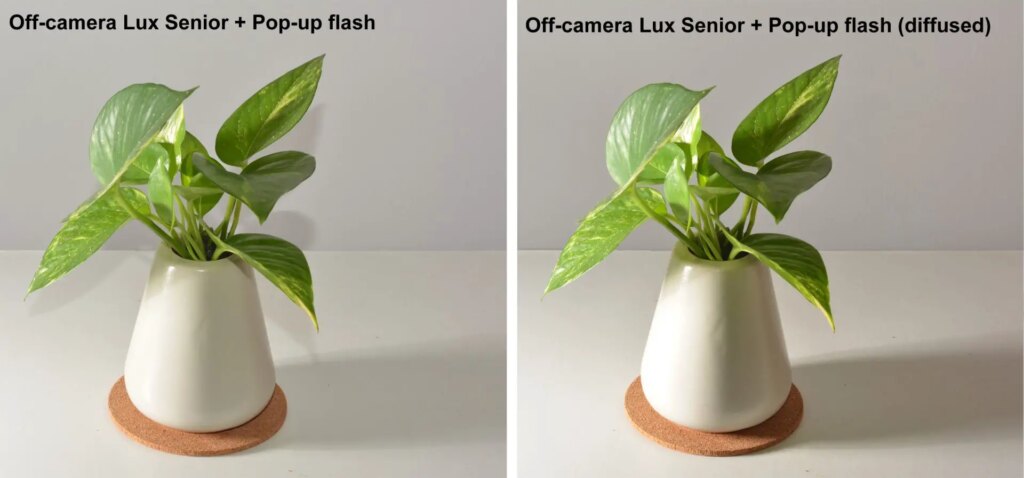
A drawback of this method is that the trigger flash (the DSLR’s built-in flash, in this instance) also affects the photo. Sometimes, that’s exactly what you want – for example, if you’re using the off-camera flash as the key light, and on-camera flash as fill.
If you don’t want the trigger flash in your photo, you have a few options. In the photo at above right, I used a diffuser over the on-camera flash, as shown below. As a result, the on-camera flash is weakened to a point where it has negligible effect on the scene, but is still strong enough to trigger the Lux Senior. So in the second photo above, there are no shadows on the wall behind the plant, and the shadow of the vase is deeper (whereas in the first photo, the on-camera flash acted as a fill light).
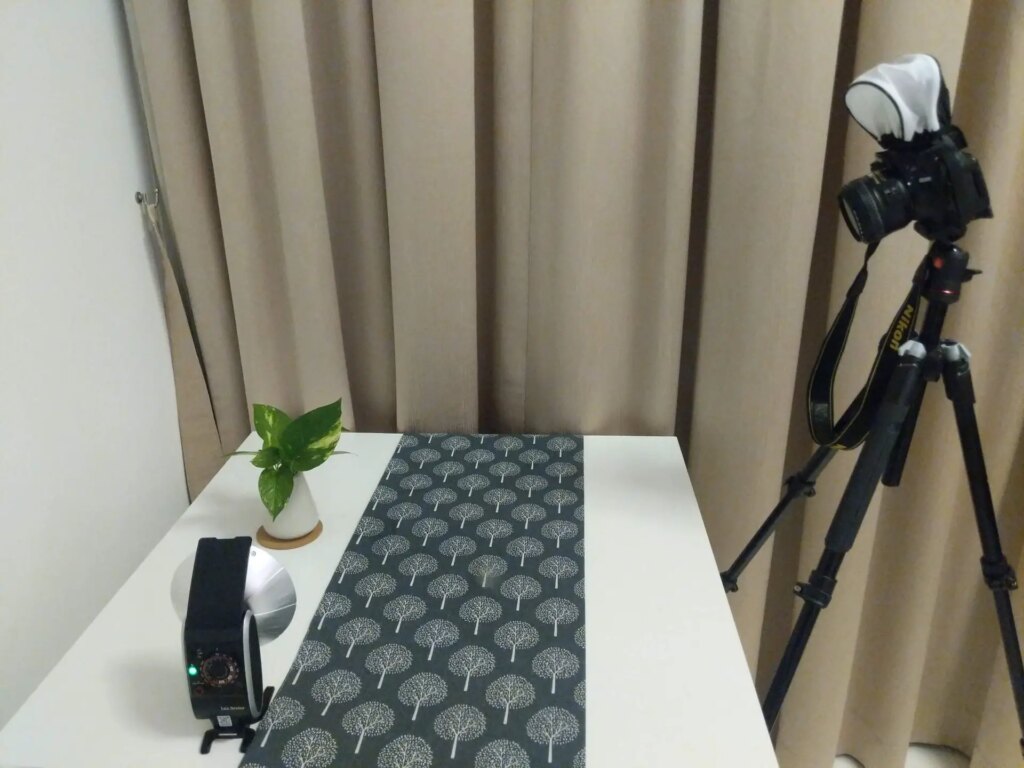
A second option is to use an on-camera speedlight as the trigger flash, with its head swivelled towards the off-camera flash. This is what I did for the two photos below, taken within minutes of each other. The first photo is with ambient light only. For the second, I dropped the ambient and lit Pearl with off-camera flash (Lux Senior).

The photos below show my setup. The on-camera flash is a Godox TT600 speedlight, zoomed to 200mm and swivelled to the left. The Lux Senior is on camera-left, nestled in my bag (the second photo shows a close-up).
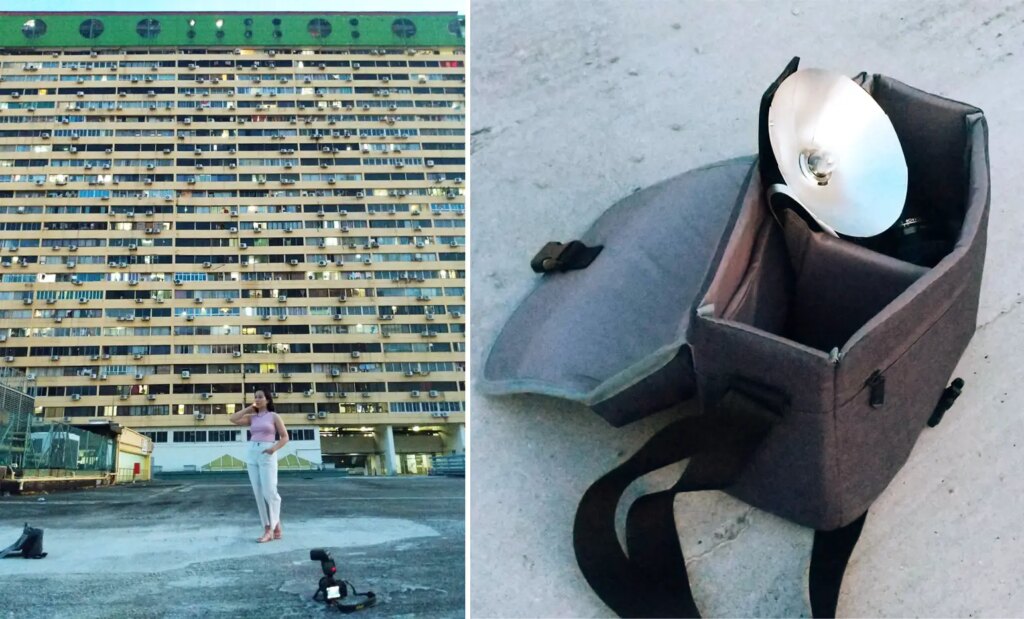
If you get close enough, simply holding the off-camera flash with your free hand will produce enough of an angle for a dramatic photo. The photo below demonstrates the technique. Once again, the Lux Senior is being triggered by an on-camera speedlight.

The next photo shows the result.

Here’s another photo with a similar set-up, but shot by my friend Redwan (the subject of the previous photo). I was on camera-left, just out of frame, holding the Lux Senior.

The next two photos are in the same tunnel, with the flash on a stand (camera-right). As before, the trigger was an on-camera speedlight. I dropped (but didn’t quite kill) the ambient, wanting to retain a bit of atmosphere. The Lux Junior (second photo) produces a harder shadow.
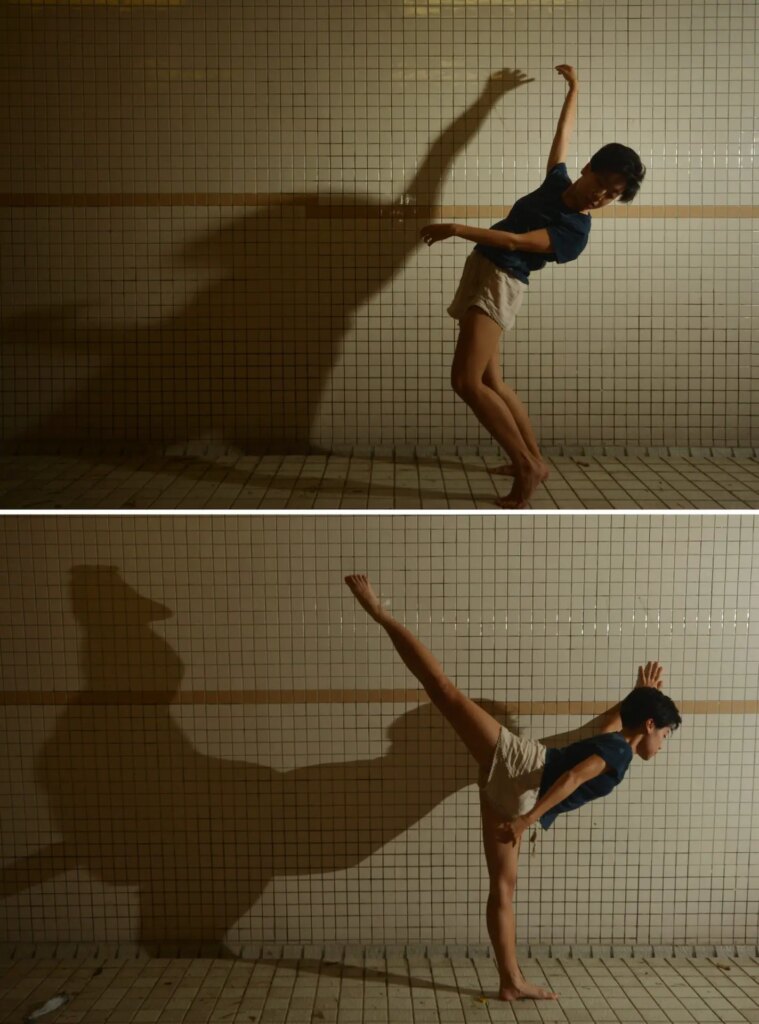
Second-curtain sync
Some product pages, such as B&H Photo, suggest that the Lux flashes don’t have second-curtain sync (aka rear-curtain sync). But it worked on my camera (Nikon D5200), and I suspect it will work on other cameras too if they allow second-curtain sync.
When you use conventional (front-curtain) sync with a long shutter speed, the flash fires at the start of the exposure, producing motion blur in the “wrong” direction, as shown in the first photo below. Rear-curtain sync ensures that the flash fires at the end of the exposure, so you get the “right” type of motion blur.
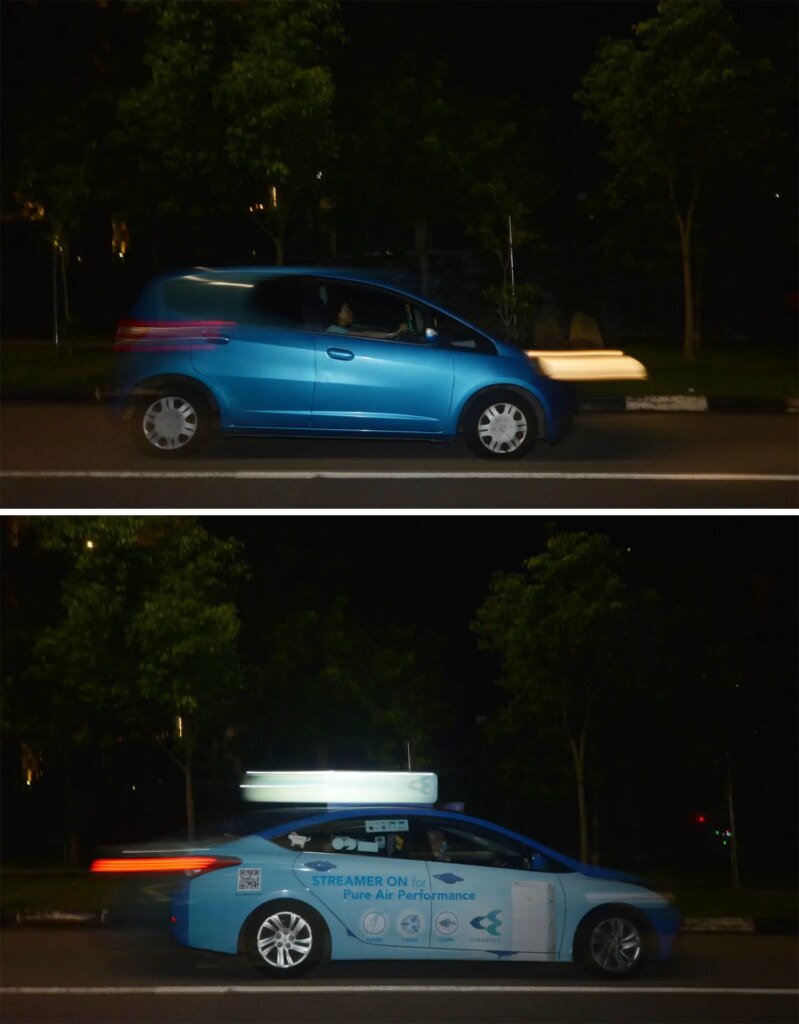
More photo samples
Digital
Now for some more sample images showing how the flashes perform in various scenarios. In the photos below, I used the Lux Senior (on-camera) as a fill flash. The effect is subtle, but an improvement – I think.


In the photo-pair below, the flash (Lux Senior) is more than just a fill-light. It overpowers the reddish ambient light, effectively “cleaning it up”. I actually prefer the first photo, but sometimes portraying the subject clearly can be more important than the mood.

In the next photo, I used a red gel on the flash (Lux Junior). I also chose a long shutter speed, and while the shutter was open, I moved the camera to make light streaks in the background – a technique known as “dragging the shutter”. The foreground is lit by flash, which is instantaneous, so there is no motion blur there.

Finally, some more off-camera action. The photo below was shot with ambient light only.

For the next photo, I used a lower ISO and smaller aperture to kill the ambient. The Lux Senior was held off-camera in my left hand, triggered by an on-camera speedlight swivelled towards it.

Film
Now let’s look at how the Godox Lux flashes play with film cameras. My Minolta Autocord TLR has a “coldshoe” – a bracket where you can mount the flash, but it doesn’t automatically sync with the shutter. Luckily, the camera has a PC sync port, and the Godox Lux flashes come with a sync cable. So mount the flash on the coldshoe, plug one end of the cable into the flash, the other into the PC sync port on the camera, and you are good to go.

The cool thing about the Autocord is that it has a leaf shutter, so you have flash sync even at 1/500 sec (my Nikon DSLR, made half a century later, is limited to a sync speed of 1/200 sec).
My Minolta X-370s SLR does have a hotshoe. For my tests, I used Fuji Velvia 50. Using flash with film is already somewhat tricky since you can’t see the result and adjust accordingly. Slide film is even trickier; it has lower dynamic range than negative film, which means there is little margin for error. Then again, if didn’t I enjoy making my life needlessly complicated, I wouldn’t be shooting film.
Where possible, I recommend bracketing. Here, the second exposure was closer to what I was going for.
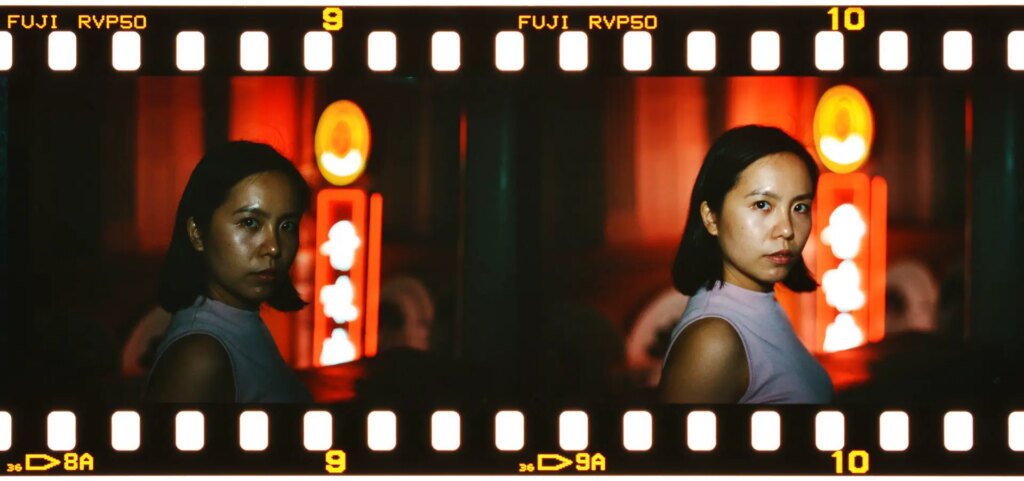
In the flower photo below, I wanted to kill the ambient, but as you can see, some background detail is still visible. I think the ambient light was too bright to be “killed”, which illustrates one of the pitfalls of using flash with film cameras.
“Killing the ambient” is typically achieved by increasing the shutter speed, which drops the ambient but not the flash exposure. However, compared to their digital descendants, film cameras with focal-plane shutters tend to have lower sync speeds (1/60 sec on my Minolta). This makes it harder to kill the ambient in bright conditions.

In the next photo, I wanted to drop (not kill) the ambient, to retain some of the atmosphere. Fluorescent lights have a greenish cast. Our eyes – and to some extent, digital sensors – can adjust, making the light look almost neutral. But daylight-balanced film like Fuji Velvia, especially when underexposed, brings out the green cast in all its glory. I rather like the effect, but not everyone does. The flash paints the subject with neutral light, making her stand out.
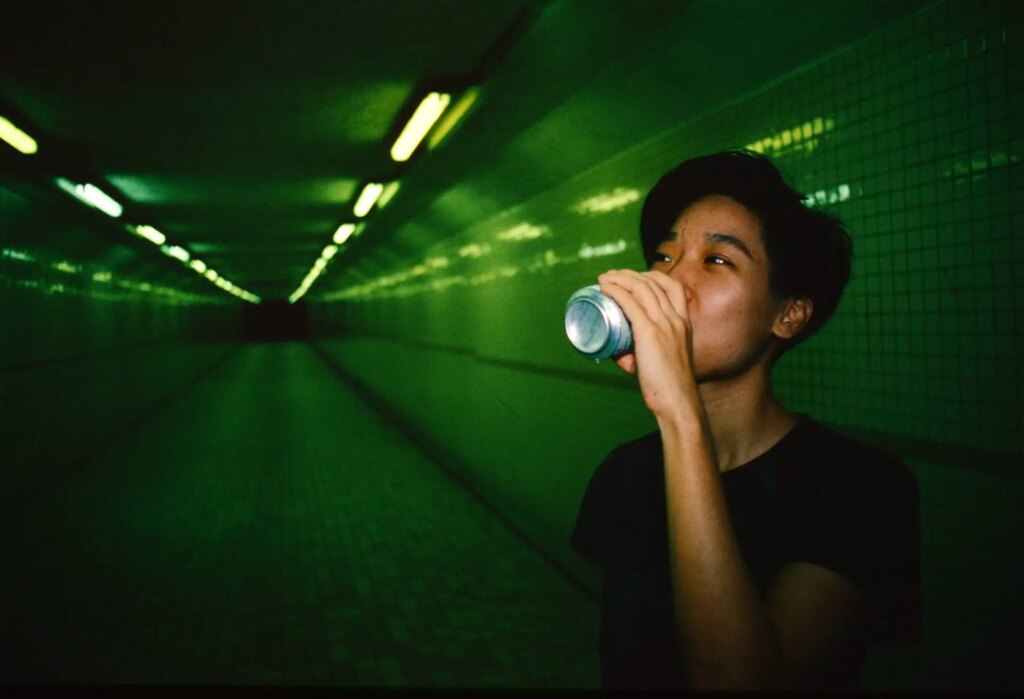
Final thoughts
At a time when the market is awash with a mind-boggling array of lighting solutions, the Godox Lux series is essentially unique – retro-styled flashes, which nevertheless boast modern features like adjustable flash power and optical control. They accessorise really well with film cameras or retro-styled digital cameras, but they pack enough features and flash power to be much more than just accessories.
Between the Godox Lux Senior and Junior flashes, which one should you choose? They both have their pros and cons, so ultimately it comes down to your needs and priorities. Both flashes look cool – cooler than conventional speedlights, in my opinion – but the Lux Senior is particularly eye-catching. Whether you’re taking photos of friends or strangers, it’s a great conversation-starter. The Junior, however, is smaller and lighter (and also cheaper).
The Lux Senior has a softer light, while the Junior is harder, and in my experience, also a little stronger. The Senior uses a lithium battery and has a faster recycle time. The Junior’s recycle time of 5 secs (at full flash power) can be a hindrance if you’re using a digital camera and shooting rapidly, but is probably fine for film. If you want to use colour gels, the Junior is a better choice because of the shape of its flash head.
As I mentioned, the Lux flashes lack some features which are available on many conventional speedlights like the Godox TT685. This is something to be aware of, but to me, it’s not a deal-breaker; rather, I see it a compromise. With the Lux series, Godox clearly set out to design flashes which are relatively cheap, compact, and with a retro design. For my money, they succeeded. We wouldn’t criticise, say, a Mini for lacking off-roading ability – it’s just not designed for it.
Assessed on their own terms, the only two improvements I can think of are: (a) instead of the screw-type hotshoe safety lock, I would like to see a quick-lock mechanism like on the Godox X2T radio trigger, and (b) a removable battery for the Godox Lux Senior, so that it can be replaced when it reaches the end of its lifespan.
If you want the retro look and feel, go for a Lux flash. If you want a full-featured speedlight, there are lots of options from Godox as well as other manufacturers. For me – and I suspect for many other amateurs – look and feel are a big part of the photography experience, and there’s nothing wrong with that. Features are nice, but taking pictures should also be fun, no? The Godox Lux flashes can help with that.
Thanks for reading. For more of my work – with and without flash – feel free to check out my Instagram.
Share this post:

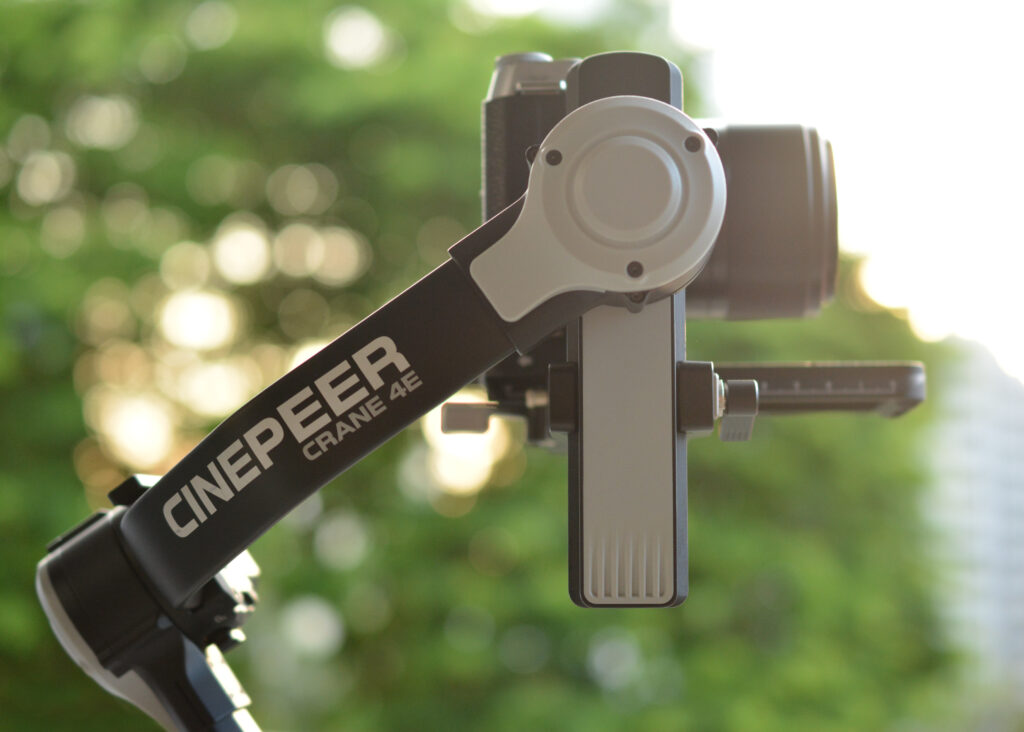
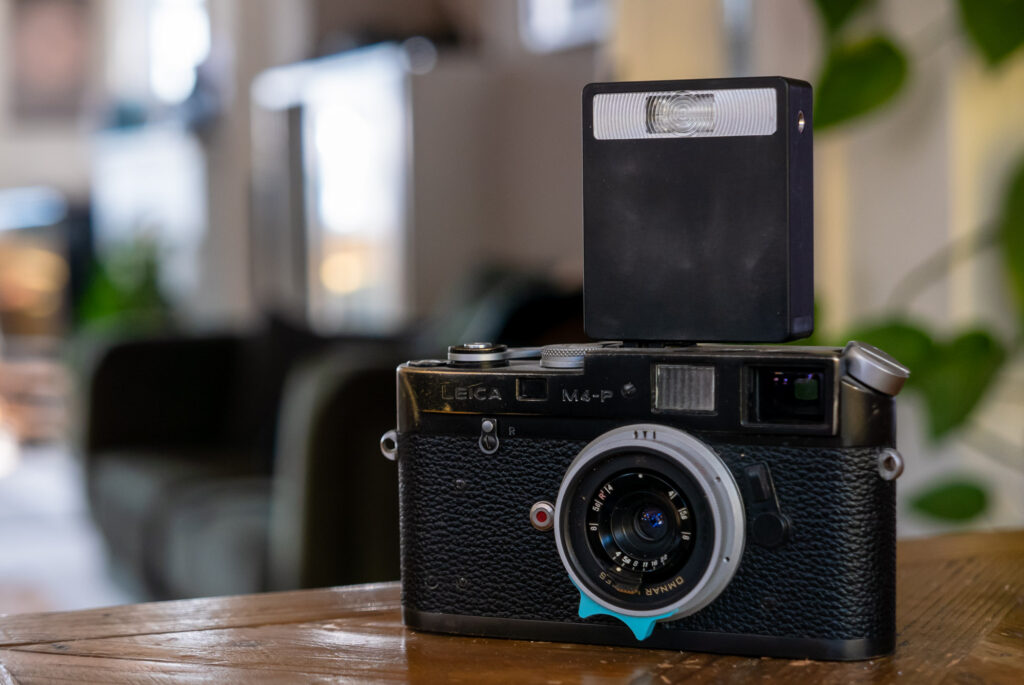
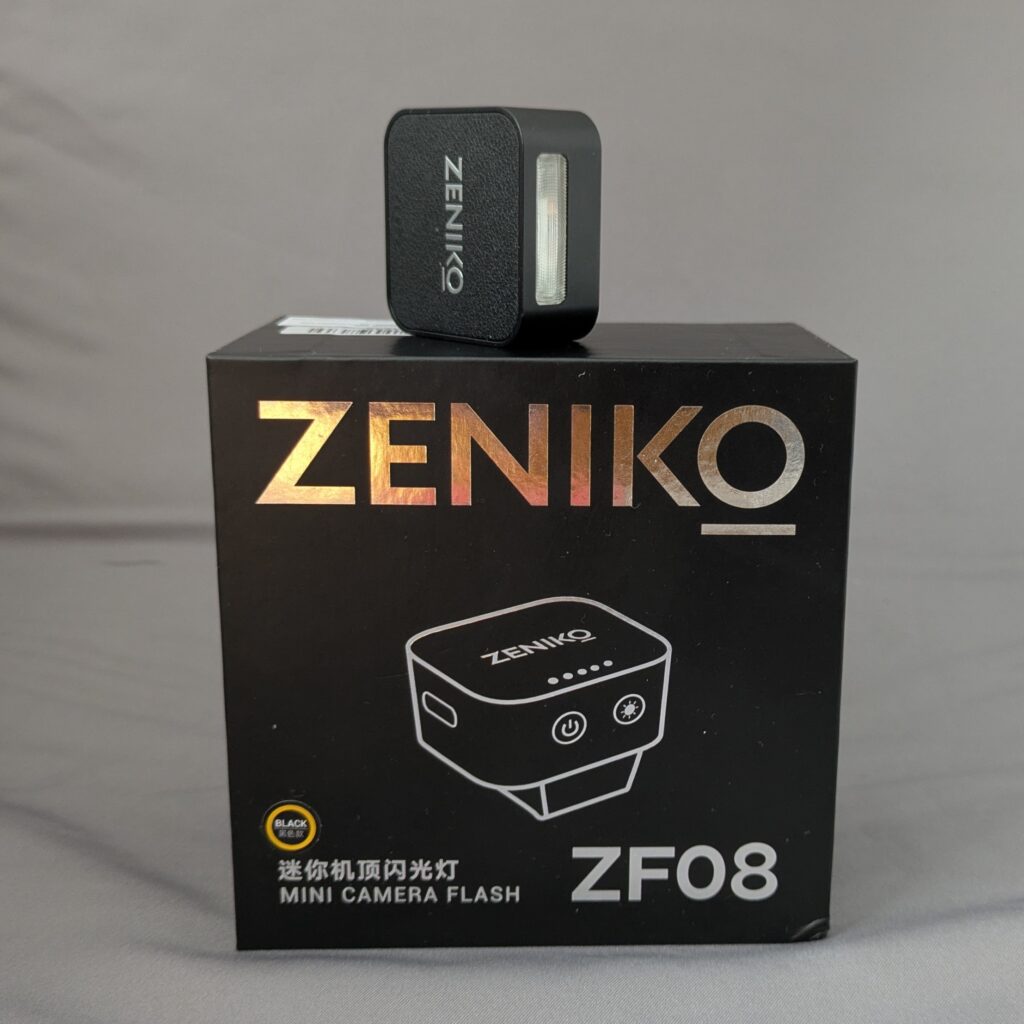




Comments
Leo Tam on Godox Lux Senior and Lux Junior Flashes – In-depth Review and Comparison – by Sroyon
Comment posted: 14/11/2022
Comment posted: 14/11/2022
Aivaras on Godox Lux Senior and Lux Junior Flashes – In-depth Review and Comparison – by Sroyon
Comment posted: 14/11/2022
Comment posted: 14/11/2022
Comment posted: 14/11/2022
Comment posted: 14/11/2022
Comment posted: 14/11/2022
Craig Schroeder on Godox Lux Senior and Lux Junior Flashes – In-depth Review and Comparison – by Sroyon
Comment posted: 14/11/2022
Comment posted: 14/11/2022
Karen McBride on Godox Lux Senior and Lux Junior Flashes – In-depth Review and Comparison – by Sroyon
Comment posted: 14/11/2022
Comment posted: 14/11/2022
Cailín Rúnda on Godox Lux Senior and Lux Junior Flashes – In-depth Review and Comparison – by Sroyon
Comment posted: 14/11/2022
Comment posted: 14/11/2022
Cameron on Godox Lux Senior and Lux Junior Flashes – In-depth Review and Comparison – by Sroyon
Comment posted: 24/12/2022
Nick Orloff on Godox Lux Senior and Lux Junior Flashes – In-depth Review and Comparison – by Sroyon
Comment posted: 26/12/2022
It's early days and I'm still working out the best way to use it, but one small hurdle I found - which is sort of mentioned in the instructions (who reads instructions?) - is that you need to put something between a metal cold shoe and the flash or it won't fire. I guess it's that the metal cold shoe shorts the flash's terminals?
My solution - a bit of clear adhesive tape on the cold shoe of my Yashica 635 seems to do the trick.
Comment posted: 26/12/2022
Will on Godox Lux Senior and Lux Junior Flashes – In-depth Review and Comparison – by Sroyon
Comment posted: 30/05/2023
I see there's a Diffuser for Godox Lux Senior Retro and I wonder how well that works when adding more power to Senior.
Comment posted: 30/05/2023
Rico on Godox Lux Senior and Lux Junior Flashes – In-depth Review and Comparison – by Sroyon
Comment posted: 29/08/2023
murray leshner on Godox Lux Senior and Lux Junior Flashes – In-depth Review and Comparison – by Sroyon
Comment posted: 26/04/2024
I wondered what the Senior cost...did I really have any use for one? How many flashes do I already have? How many work and how many are friendly to my current cameras?
Nah...then looked on eBay. Someone was selling one as 'broken' because the power dial was extremely difficult to rotate', despite working wherever the dial was 'stuck. Everything was provided, box, cables, manual, etc.
I just retired from a career that ended with 'repairing the unrepairable', for reasons beyond the scope of reasonable rambling, for the final 12 years or so. I could handle this and live to tell the tale. I know all about letting the Coulombs out of the charged capacitor(s) instead of absorbing them into adventurous body parts. It was listed for USD35 including shipping + local sales tax, or Make Offer. I was so confident I could fix it I just paid the asking price. No reason to add insult to injury for the seller. (Actually, I think the seller sells warranty returns and other disappointments). USD 37.09 delivered.
I turned in on, saw it was partially charged, and instinctively plugged it in to to charge it, anticipating the red power indicator might turn green. I went out to run some errands, came back and it was indeed green. I then remembered I had 500 or so flashes worth of energy to discharge before opening it. A screwdriver works to discharge something that hasn't been powered up for a long time (potentially years with some antiques), but shorting a fully charged capacitor in a device you intend to salvage isn't advisable.
Hmmm...there are no screws visible...maybe some 'loose' ones in the observer...I don't want to start pulling all the decorative material off, starting on the wrong side, with my luck. Maybe I needed to look on a hack/repair website first...
What's wrong with it anyway...the seller can't turn the dial to 11?
About 15 seconds later I realized if I posed my fingers like I had arthritis and was holding an empty wine glass, I could apply the required asymmetrical (appropriate word by sheer luck) torque on the dial and easily rotate it one step at a time over the full range, then tried all the power levels from full to 1/64, side-eying a mirror on a door to not look directly at 7 flashes. It works! ... and I can rotate the dial back in the opposite direction with slightly different hand grip...like holding the wine glass while drinking from it.
Now I realize I can't connect it to my Sony NEX-7 that has a proprietary hotshoe...and can't find the hotshoe adapter I bought for it...so I ordered another, and a diffuser, too...why not, it doesn't tilt...so it cost a little more than it initially appeared.
The other camera cued/queued up to try is a serviced 1945 Kodak Medalist II, with that annoying ASA Bayonette connector. I will look in the basement for a while for a cable to splice a PC connector onto before I pay USD 30-65 for another to amputate.
Maybe I needed a small (GN 14?), cute flash. My other working one is an Agfatronic 643CS (GN 212) with which I gave someone a sunburn across the table at a wedding once, leaving it on full power instead of Auto. He said 'Ouch' and I realized I would have to figure out a special recipe to develop that film...five+ years ago...maybe this year.
So now I just need suitable adaptation to use it.
Thanks for showing me this flash and diverting me from looking for flash bulbs in the basement.
Comment posted: 26/04/2024